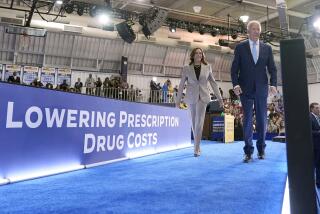Review your Medicare Part D options before sign-ups start
- Share via
The sign-up period for Medicare Part D (Medicare’s prescription drug program) for 2011 runs Nov. 15 to Dec. 31. Here’s our best tip: Start reviewing your options now.
Eligible seniors (anyone with Medicare Part A and/or Part B) can choose from among several dozen plans in their area. Each covers different lists of drugs and has different costs for premiums, deductibles and co-pays. “Getting a plan that covers all of the drugs you take with no restrictions, for the lowest cost, requires seniors to review and compare their options,” says Elaine Wong Eakin, executive director of California Health Advocates, a Medicare education and advocacy organization based in Sacramento.
There are a lot of plans to review — an average of 33 per state, according to the Kaiser Family Foundation, a health policy and communications group in Menlo Park, Calif. And the plans change each year, so the plan you had in 2010 may shed some drug options or raise some costs. So don’t just stick with the plan you had for 2010: compare, compare, compare. According to the Kaiser Family Foundation, the average premium increase will be 10%, or $40.72 per month, though plans can run lower or higher.
Wal-Mart Preferred RX, for example, is a new Part D plan offered throughout the U.S. by Humana, a national insurer, and Wal-Mart, with a monthly premium of $14.80. But note that the premium is just one of the costs you pay, says Joe Baker, president of the Medicare Rights Center, based in New York City. If the plan doesn’t include all the drugs you take and you have to pay out of pocket, you could incur higher costs than you might have with a plan with a higher monthly premium that does cover your drugs.
Beyond costs, look at any rules the plans set out for getting a drug your doctor prescribes, Baker adds. Some plans require the beneficiary, or his or her physician, to get prior approval from the insurer even for a drug in the plan’s formulary. Some may require “step therapy” before allowing a drug they deem expensive — in other words, you have to try less expensive drugs and only get the pricier ones if the first ones are not effective for you.
And some plans may limit the quantity of a drug they will cover; cost for the rest comes out of your pocket.
The 2011 Part D plan also brings some key changes.
• Participants with incomes higher than $85,000 per individual or $170,000 per couple will see higher premiums than people with lower incomes. If you’re in one of those categories, expect a letter from Social Security letting you know about the higher cost.
• In 2011, when Part D participants reach $2,840 in total drugs costs (what they pay plus what the plan pays) for drugs covered by their plan, they enter the coverage gap, which is also known as the doughnut hole. Beginning next year, people will not have to spend as much out of their own pockets to get out of the doughnut hole.
The change: People who reach the gap in 2011 get a 50% discount on all brand-name drugs and a 7% discount on generic drugs. They will remain in the gap until the total cost of drugs (what they pay, what the plan pays and the amount covered by the 50% discount for brand-name drugs) reaches $6,440. (Note, however, that the 7% discount on generic drugs will not count toward the total cost of drugs.) After reaching $6,440 in total drug costs, Part D beneficiaries pay no more than 5% of the cost of the drugs allowed by their plan.
Low-income beneficiaries may be eligible for Medicare’s Extra Help program, which covers some Part D costs. To see if you’re eligible, call the Social Security Administration at (800) 772-1213.
More to Read
Inside the business of entertainment
The Wide Shot brings you news, analysis and insights on everything from streaming wars to production — and what it all means for the future.
You may occasionally receive promotional content from the Los Angeles Times.










